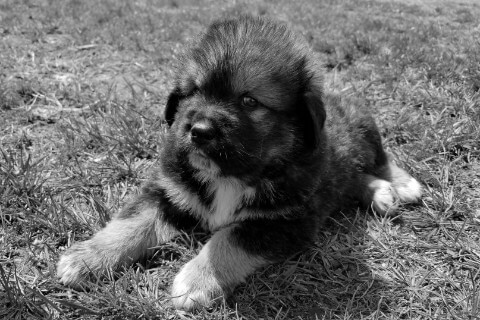
Nicholas Stabenow-Schneider | Black Feather Tibetan Mastiffs
Nicholas Stabenow-Schneider is the breeder behind Black Feather Tibetan Mastiffs. Read about the kennel’s origins, puppies, and much more!
Home » Meet The Breeds » Tibetan Mastiff Dog Breed
Lee Whittier
08/07/2024
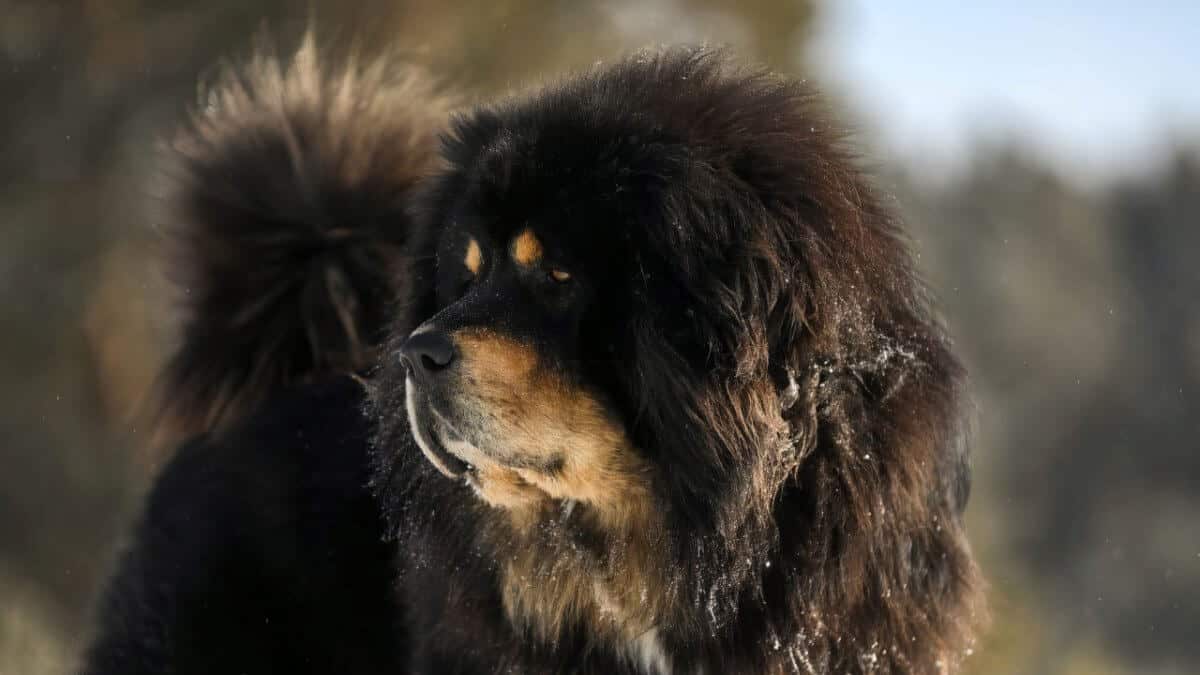
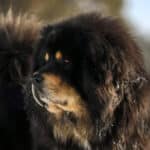

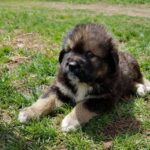


The Tibetan Mastiff (TM) is a primitive breed of great size and substance that has a dense, stand-off coat. This breed is very devoted to its family, but usually chooses one person who is their best friend.
The Tibetan Mastiff is a guardian breed that often acted independently with nomadic herders and outside monastery walls. They were often tied out in grasslands with yaks or goats, or placed near entrances to chase off predators like snow leopards. Thus, the TM may appear to be stubborn and aloof; needing to believe that training is his own idea rather than that of its owner/s.
Working
24 – 26 inches
70 – 150 pounds
10 – 12 years
| Country of Origin | Tibet |
|---|---|
| Bred For | Traditional Guard of Monasteries and Nomad Livestock Guardian |
| Known For | Imposing Size and Substance, Heavy Coat with Ruff, Loud Bark, Guardian Capabilities |
| Popularity | Low |
| Temperament | Intelligent, independent, strong-willed and rather reserved. He is aloof with strangers and highly protective of his people and his property. He is a guardian above all. |
| Activities | Self-exercising Breed; Forced Exercise not Recommended, Mental Stimulation and Learning |
The Tibetan Mastiff has a history steeped in legend. It is thought by some to be one of the most ancient breeds and the forbearer of all mastiff-type dogs. Ancient records from around 1100 BC mention large dogs in China, and these ancestors likely accompanied armies of the Assyrians, Persians, Greeks, and Romans.
Since few Westerners were permitted into Tibet before the 1800s, the Western world was largely unaware of this breed’s existence. The early British explorers brought attention to a giant breed of dog in the Himalayas. In 1873, the Royal Kennel Club officially recognized the breed. In the late 1950s, the President of the United States received two Tibetan Mastiffs, which were subsequently sent to the Midwest; however, despite research, further information has yet to become available. Since the 1970s, more dogs have been imported to the United States, and numerous litters are being whelped every year.
Their long history with humans has given Tibetan Mastiffs an almost uncanny “human” understanding. Unlike some breeds that are bred for their function, the TM evolved as a result of its function. Their role as guardians for thousands of years made them into loyal companions, unafraid to defend the herders they accompanied or the monasteries where they resided. Their role as guardians has shaped them into dogs with controlled strength, fearlessness, patience, loyalty, and gentleness. Their dense, double, stand-off coat gave them protection from the harsh elements of the Himalayas. Today, they are popular as companions and protectors around the world.
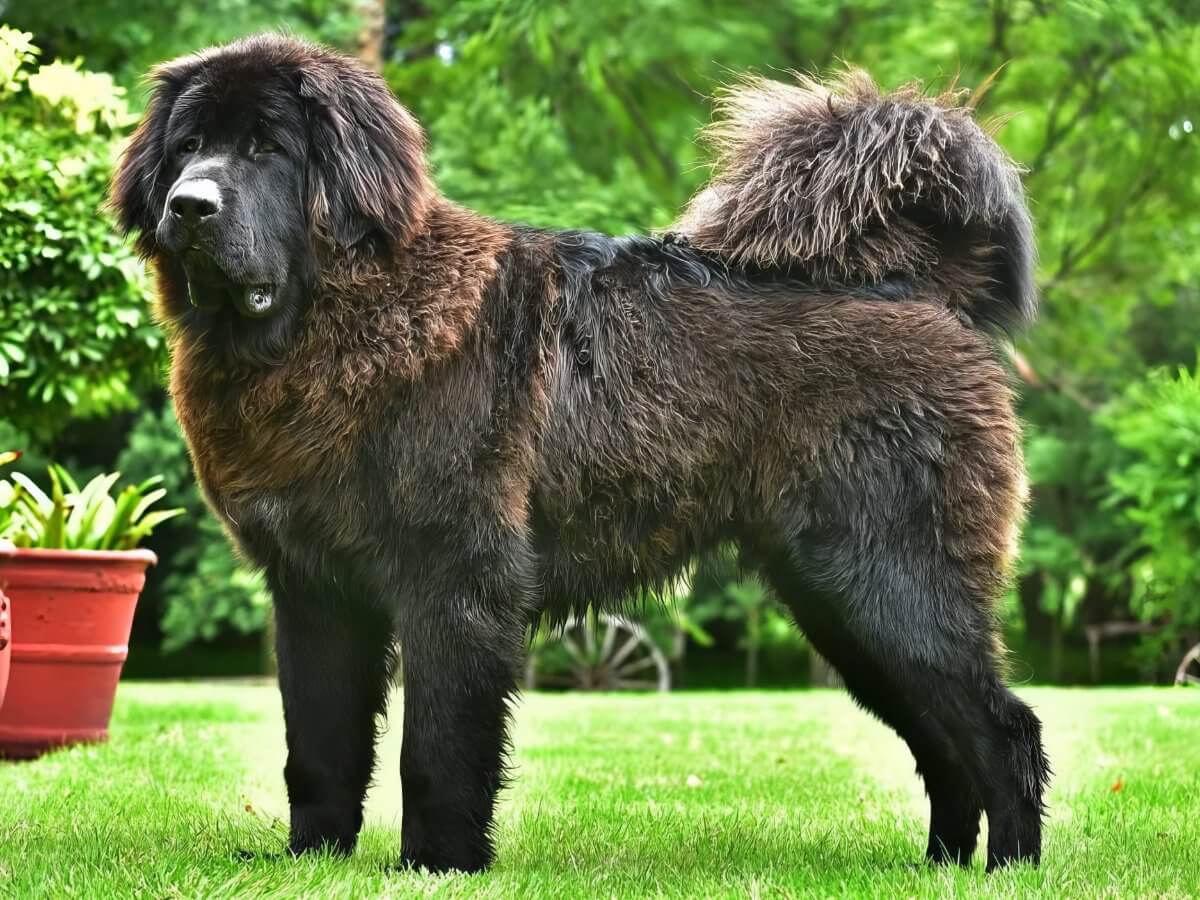
The size of the Tibetan Mastiff is an essential characteristic of the breed. This fearless guardian must be at least 25 inches tall at the withers for males and 23 inches for females. Under this size is a disqualification in the American Breed Standard. The preferred range is 26 to 29 inches for males and 24 to 27 inches for females. Although there is no specified weight range, this breed can weigh well over 100 pounds.
The breed should measure slightly longer than tall (10-9), (i.e., the length to height, measured from front to rear, is greater than the withers to ground). The Tibetan Mastiff should have remarkable substance in relation to its size, in bone, body, and muscle.
Texture: Many Tibetan Mastiff owners were first attracted to the dense, double, stand-off coat. It is made up of fairly long, thick, coarse guard hair, with a heavy, soft undercoat. Hair is fine but hard and straight; never silky, curly or wavy. The heavy coat around the neck and shoulders gives a mane-like appearance. The tail has especially heavy feathering.
| Standard Color | |
|---|---|
| Cream Sable | n |
| Blue Gray | ee |
| Brown & Tan | ee |
| Red Gold Sable | ee |
| Blue Gray & Tan | ee |
| Black | ee |
| Black & Tan | ee |
| Brown | ee |
| Red Gold | ee |
| Cream | n |
| Standard Marking | |
|---|---|
| White Markings | ee |
A Note About Color: Colors include Black, Brown, and Blue/Grey, all with or without tan markings, ranging from light silver to a rich mahogany, and Gold, with shades ranging from a pure golden to a rich red gold. White markings on the chest and feet are acceptable. Undercoat may be lighter shades of the dominant color. The undercoat on black and tan dogs also may be grey or tan. Sabling, other than wolf sable and sabling in a saddle-marked color pattern, is acceptable on gold dogs. Large white markings are to be faulted. Tan markings may appear at any or all of the following areas on all but Gold dogs: above eyes as spots, around eyes (including spectacle markings), on each side of the muzzle, on throat, on lower part of front forelegs and extending up the inside of the forelegs, on inside of rear legs showing down the front of the stifle and broadening out to the front of the rear legs from hock to toes, on breeches, and underside of tail.
Disqualifications – All other coat colors (e.g., white, cream, wolf sable, brindle and particolors) and markings other than those specifically described.
The Tibetan Mastiff head and expression are hallmarks of the breed. The head is broad, strong with heavy brow ridges. The mature dog may have a single wrinkle from above the eyes around to the mouth. More wrinkle than that is severely faulted.
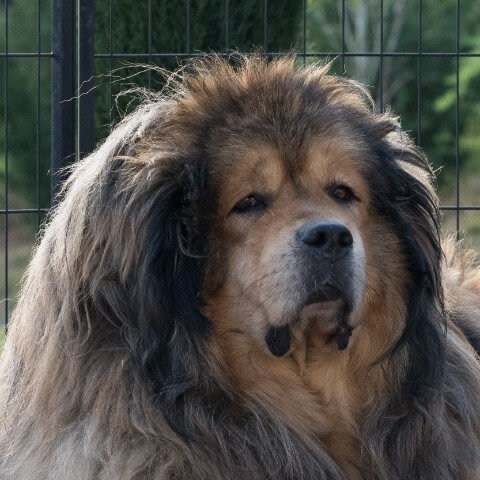
Balancing the head, the tail is well feathered, medium to long, not reaching below the hock. It is set high on the line of the back. When alert or in motion, the tail is always carried curled over the back, but it may be carried down when the dog is relaxed.
Choosing a Tibetan Mastiff as a companion requires extensive socialization for a longer period of time compared to other breeds. Regular walks and trips to various places take time and dedication.
The TM is highly intelligent and is easily bored, leading to destructive behaviors. Chewing and digging are his favorite activities as a youngster. With their strong jaws, they enjoy chewing and digging, often creating large holes that some owners humorously refer to as “new landscaping.”
New puppy owners should not be discouraged if their Tibetan Mastiff doesn’t sit, stay, or come like other puppies in class. Tibetan Mastiffs are not naturally obedient! These classes are as much for socialization as they are for training.
Information from the Orthopedic Foundation for Animals (OFA) and from breeders indicates that the Tibetan Mastiff is a relatively healthy breed. Their AKC parent club, the American Tibetan Mastiff Association, recommends only four health tests are needed, and the breed’s longevity extends into the double digits. This is quite good for a breed of such great size.
Lifespan: The Tibetan Mastiff can easily enjoy life for ten to twelve years. Although some succumb earlier, others enjoy more time well into their senior years.
Typically the Tibetan Mastiff is a hardy breed; however, like all breeds and mixed breeds, they can be predisposed to certain health concerns. Some of the more common issues that are routinely tested for are:
All test results should be submitted to the OFA registry for verification and submission to the OFA Database.
Tibetan Mastiffs make their own decisions, displaying a high level of cognitive ability that you will come to appreciate over time. They do not seek or need your approval. They will communicate when they need attention and when they desire it.
The TM is typically not always eager to please their owners. This trait is rooted in their development over thousands of years as guardians. They have learned survival instincts and how to read situations. When they are extremely determined to get their own way, it’s likely because they perceive something you don’t.
Due to centuries of being bred to guard flocks, homesteads, and monasteries, Tibetan Mastiffs tend to be “night barkers.” This behavior should be considered before making the commitment to own one, and whether it will sleep indoors or outdoors at night.
Primitive breeds that evolved in difficult conditions survived in spite of not eating for four or even five days. Many Tibetan Mastiffs, particularly the males, are poor eaters.
Thyroid disease may contribute to eating issues in the breed. If the test results are normal, you can be relatively sure that your dog is a survivalist and will stay healthy despite a low food intake.
Proper nutrition is not just important, but essential for the TM’s vitality and longevity. A balanced and nutritious diet is the foundation of good health, so it’s crucial to feed a high-quality commercial dog food or a well-balanced homemade diet.
A healthy weight is crucial for the TM’s overall well-being. Portion sizes should be based on the dog’s age, activity level, and overall health.
The Tibetan Mastiff’s thick coat makes it susceptible to overheating. Fresh water should always be readily available, especially after meals and following any physical activity. In warmer climates, providing clean drinking water and a cool place to rest after mealtimes is particularly crucial.
The Tibetan Mastiff is a fast learner. However, it’s crucial to understand that they need to know “why” before they will follow commands. They aren’t particularly motivated by food, so using treats as a training method might not be very effective.
Although obedience is not natural to the temperament of the TM, more and more of them successfully show in Obedience competitions. When training, begin with small, daily tasks such as nail trimming. This seemingly simple task not only accomplishes an essential grooming function, it also establishes an ongoing relationship of coexistence and cooperation between owner and companion.
A Tibetan Mastiff needs a fenced yard, although the size does depend upon the individual dog. While they are an active dog out-of-doors, they are usually fairly quiet when in the house.
Forced exercise is not recommended. They are a self-exercising breed. Any forced exercise may lead to stress on the joints and intermittent or permanent lameness.
| Energy Level | Low |
|---|---|
| Exercise Requirements | 30 Minutes/Day, Daily Walks, Mental Stimulation |
The amount of time required for grooming depends on the quality of the coat. A stellar coat may only need weekly brushing (unless shedding, then daily brushing is required). That same coat may only require quarterly bathing.
A lesser coat, or that of a neutered Tibetan Mastiff (the TM may develop a softer and more profuse coat after neutering), may require quite a bit more brushing and bathing due to a coat that has more undercoat and retains stains, odors, and mats easily. Climate will also be a factor in the amount of care needed.
| Coat Type | Double, Medium |
|---|---|
| Grooming Requirements | Weekly brushing unless shedding, then daily brushing required. Bathing once a month to once a quarter, depending on coat quality and climate. Routine Ear Cleaning, Weekly Nail Trimming, Daily Tooth Brushing |
Routine ear cleaning, daily or weekly nail trimming, and daily tooth brushing are all part of keeping your dog healthy in all ways.
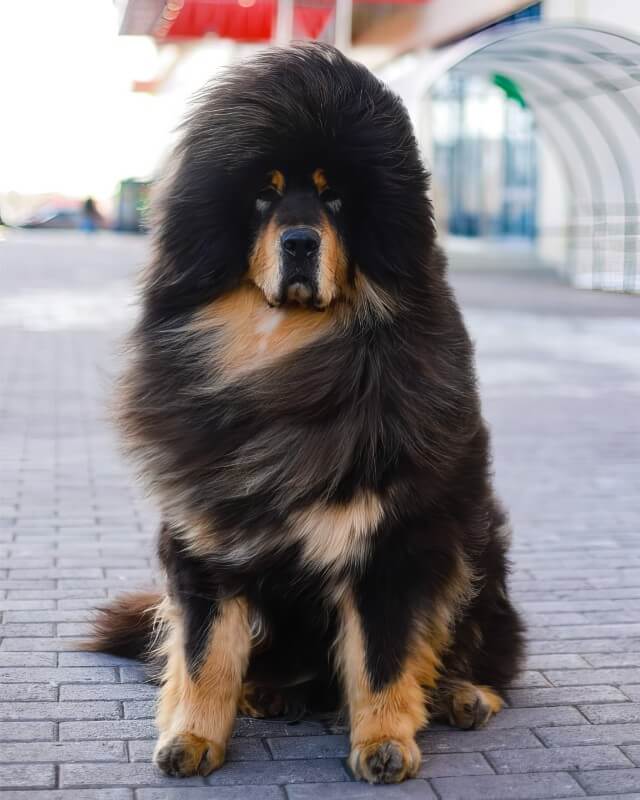
Socialization is essential and ongoing for this breed. A beautiful and well-behaved Tibetan Mastiff is a treat to have around and an excellent advertisement for the breed.
The Tibetan Mastiff has a few unique traits. In spite of numerous success stories regarding formal Obedience training and competition, they are not always willing to please their owners.
The TM may be very determined to get its own way. The breed has cat-like behaviors; think big cat.
The Tibetan Mastiff was bred to guard, and guard he will. However, the owner must be the one to decide who comes and goes in the home. The Tibetan Mastiff tends to make decisions on his own, deciding who to guard and when, so be prepared to monitor friends and visitors entering the property that your dog thinks is his territory.
The arrival of a litter of Tibetan Mastiff puppies is always thrilling for a preservation breeder. With their fluffy coats and playful behavior, these puppies can captivate anyone for hours as they interact with each other and their mother. With joy comes the responsibility to place the puppies in homes that understand the need for setting boundaries and socialization. Full of energy, TM puppies are eager to explore their environment and form strong bonds with their human families.
Socialization: It’s crucial to socialize your Tibetan Mastiff. Without proper socialization, including trips to town, playgrounds, and dog parks, your TM may become overly protective and difficult to manage by the age of two or three.
The Tibetan Mastiff can enjoy participation in dog sports just as much as the next breed. Training should consider the breed’s independence as well as its intelligence. It is not naturally obedient or social. The Tibetan Mastiff is a fast learner, but strong-willed and sometimes stubborn.
Not all AKC activities are appropriate from the standpoint of a TM’s natural temperament. Most do well in Rally, advanced Obedience is challenging, but a growing number have been trained and compete successfully in AKC Obedience Trials. Many TMs enjoy Fast CAT, but avoid the temptation to start before they are fully mature.
Engaging a Tibetan Mastiff in various activities and organized sports satisfies the dog’s desire to share experiences with its favorite person. Once the TM is given the “why,” he will provide the “how.”
The Tibetan Mastiff is recognized by the world’s leading registries and kennel organizations, which categorize the breed into a specific Group based on its unique characteristics. This breed is recognized worldwide under the following Group designations:
| Organization | Group Designation |
|---|---|
| AKC (American Kennel Club) | Working |
| UKC (United Kennel Club) | Guardian |
| CKC (Canadian Kennel Club) | Working |
| ANKC (Australian National Kennel Council) | Utility |
| RKC (The Royal Kennel Club) | Working |
| FCI (Fédération Cynologique Internationale) | Group 2: Pinscher and Schnauzer Molossoid Breeds – Swiss Mountain and Cattle Dogs; Section 2.2: Molossoid Breeds, Mountain Type |
The ideal Tibetan Mastiff is described by a Breed Standard that is approved by each of the world’s leading registries and kennel organizations. The Breed Standards for this breed may be found in the following links:
| Organization | Breed Standard |
|---|---|
| American Kennel Club | AKC Tibetan Mastiff Breed Standard |
| United Kennel Club | UKC Tibetan Mastiff Breed Standard |
| Canadian Kennel Club | CKC Tibetan Mastiff Breed Standard |
| Australian National Kennel Council | ANKC Tibetan Mastiff Breed Standard |
| The Royal Kennel Club | RKC Tibetan Mastiff Breed Standard |
| Fédération Cynologique Internationale | FCI Tibetan Mastiff Breed Standard |
Purebred dogs are supported by members of breed clubs who dedicate their efforts to the betterment and preservation of a specific breed.
The American Tibetan Mastiff Association, serving the United States and Canada, is the AKC-recognized “parent club” for the breed. Founded in 1974, the club promotes responsible breeding practices, upholds its by-laws, and organizes National Specialty shows and other events. Dedicated to the welfare of the TM, the association fosters education and celebrates the unique characteristics of these extraordinary dogs.
Although there is no official Tibetan Mastiff club in Canada, the US counterpart is unofficially available throughout North America.
In the United Kingdom, the Tibetan Mastiff Club of Great Britain is the breed’s parent club. Established in 1895, the association not only offers a platform for breeders and owners to connect and compete, it also actively champions the betterment of the breed’s health and welfare throughout the British Isles.
Membership or affiliation with these clubs can offer Tibetan Mastiff enthusiasts access to a wealth of knowledge, regional and national events, and a community that shares a common love for this ancient breed.
Rescue groups play an invaluable role in supporting the needs of individual dogs, providing shelter, care, and new beginnings for any Tibetan Mastiff in need. Rescue organizations and their volunteers are dedicated to the rehabilitation and rehoming of these dignified and deserving companions.
In the United States, the Tibetan Mastiff Rescue, Inc. is a separate entity from the parent club in the US. This group focuses on the rescue, rehabilitation, and rehoming of the purebred TM for family living. Although there is no official rescue in Canada, the US counterpart gives unofficial assistance when possible.
For those in the United Kingdom, Tibetan Mastiff Club of Great Britain FB Rescue contact: offers support, rehoming services, and education for individuals looking to adopt one of these powerful protectors. Acquiring a rescued TM can be a rewarding experience, as it provides a loving home to a loyal dog in need.
Yes, Tibetan Mastiffs shed. The breed’s double, stand-off coat sheds in the spring or early summer. The coat that is glorious most of the year requires weekly brushing and regular baths.
No coated dog is completely hypoallergenic, but some breeds are more suitable for people with allergies. TMs, with their thick double coat that sheds regularly, can spread more dander, which may cause issues for those with allergies.
Standing 29 inches tall at the shoulder, the Tibetan Mastiff can weigh well over 100 pounds.
Tibetan Mastiffs can display dominance over unfamiliar dogs when first introduced. They generally get along well with other animals and guests if properly introduced, but should be carefully supervised with new animals. They may also show aggression towards dogs of the same sex.
On average, the Tibetan Mastiff lifespan is 10 to 12 years, though sometimes they live longer with proper care, a balanced diet, and regular veterinary check-ups.
Although the breed sprang from its function as a guarding breed, TMs may have traveled long distances through countries with the armies of the Assyrians, Persians, Greeks, and Romans.
Tibetan Mastiffs, especially as puppies and young adults, can be highly destructive. They have exceptionally strong jaws and are known to chew through doors, chain-link fences, concrete, and almost anything else. Be prepared for a certain amount of damage caused by your Tibetan Mastiff, particularly during their first three years.
Tibetan Mastiffs are considered high maintenance in terms of their socialization and training. The coat needs regular brushing to prevent matting and extensive attention during coat changes.
In terms of exercise, these dogs are typically content with hanging out at home and some playtime with their favorite person. However, it’s important to remember that proper training and socialization are necessary to ensure these intelligent and independent dogs are well-behaved and well-adjusted.

Ms. Lee Whittier has been involved in the sport of purebred dogs for over three decades. Her involvement began as an owner, exhibitor and, subsequently, a breeder of Rottweilers. She has owned Akitas, Bullmastiffs, and a Sussex Spaniel. She currently owns, breeds, and exhibits Tibetan Terriers. Ms. Whittier began judging in 2000, and then took a hiatus for several years to work for the American Kennel Club as an Executive Field Representative in the Pacific Northwest. She returned to judging in 2011, and currently judges the Working, Terrier, Toy, and Non-Sporting Groups, seventeen Hound Breeds, ten Sporting Breeds, Bouvier des Flandres, and Best in Show. Ms. Whittier has judged dog shows around the world, from the United States, Canada, South America, and Asia, at shows large and small; all of great importance to each and every exhibitor. Some of the larger shows are Westminster Kennel Club, Kennel Club of Philadelphia, Del Valle Dog Club of Livermore, Great Western Terrier Association, Northern California Terrier Association, Hatboro Dog Club, Inc., Malibu Kennel Club, and the Kennel Club of Palm Springs. Ms. Whittier is a standing member of Dog Fanciers of Oregon, The Central Florida Cairn Terrier Club, Columbia River Cairn Terrier Association, and the Tibetan Terrier Club of America. As an active member in numerous clubs, she has worked in the capacity of Show Chair, President, Vice-President, Secretary, Board Member, and Constitution & By-Laws Revision Committee Member. In addition to judging, Ms. Whittier developed the Dog Show Mentor program, exclusively for owner handlers. This is an online program where owner handlers of all stages and levels learn to develop an individual, strategic approach to showing dogs. She also travels to speak to owner handlers all over the world. She currently lives in Vancouver, Washington, with her husband, Wayne, and their three Tibetan Terriers. Her other interests include gardening and hiking with the dogs.

Nicholas Stabenow-Schneider is the breeder behind Black Feather Tibetan Mastiffs. Read about the kennel’s origins, puppies, and much more!
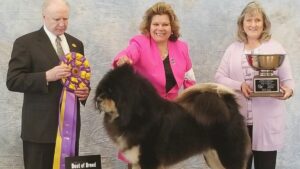
Debra Parsons Slayton is breeder behind DreamCatcher Tibetan Mastiffs. Read about the kennel’s beginnings, the puppies, and much more!
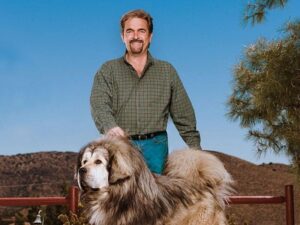
Richard Eichhorn is the breeder behind DRAKYI Tibetan Mastiffs. Read about the kennel’s beginnings, the puppies, and much more!
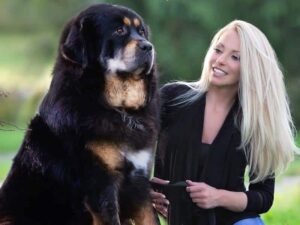
Crystal Cosgrove is the breeder behind Adynasty Tibetan Mastiffs. Read about the kennel’s beginnings, the puppies, and much more!
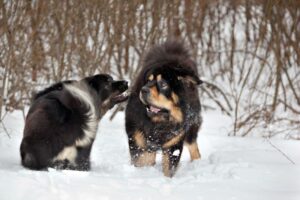
Discover the nature of the Tibetan Mastiff and why we must respect their centuries-old breeding. Learn how to honor these magnificent dogs.
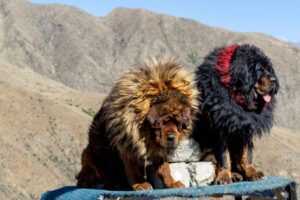
Explore the history and nature of Tibetan Mastiff dogs and learn why they may not be the best choice for a livestock guardian dog.
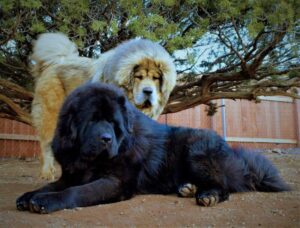
Discover the defining head features of the Tibetan Mastiff: the broad and massive skull, almond-shaped eyes, thick mane, and square muzzle.
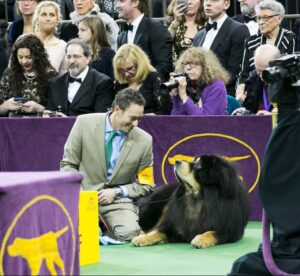
Dan Nechemias & Lois Claus from Dawa Tibetan Mastiffs, breeder interview by Allan Reznik. Where did each of you grow up? Lois grew up in

Nicholas Stabenow-Schneider is the breeder behind Black Feather Tibetan Mastiffs. Read about the kennel’s origins, puppies, and much more!

Debra Parsons Slayton is breeder behind DreamCatcher Tibetan Mastiffs. Read about the kennel’s beginnings, the puppies, and much more!

Richard Eichhorn is the breeder behind DRAKYI Tibetan Mastiffs. Read about the kennel’s beginnings, the puppies, and much more!

Crystal Cosgrove is the breeder behind Adynasty Tibetan Mastiffs. Read about the kennel’s beginnings, the puppies, and much more!

Discover the nature of the Tibetan Mastiff and why we must respect their centuries-old breeding. Learn how to honor these magnificent dogs.

Explore the history and nature of Tibetan Mastiff dogs and learn why they may not be the best choice for a livestock guardian dog.

Discover the defining head features of the Tibetan Mastiff: the broad and massive skull, almond-shaped eyes, thick mane, and square muzzle.

Dan Nechemias & Lois Claus from Dawa Tibetan Mastiffs, breeder interview by Allan Reznik. Where did each of you grow up? Lois grew up in
The best way to ensure a long and happy relationship with a purebred dog is to purchase one from a responsible breeder. Not sure where to begin?
Contact the National Parent Club’s Breeder Referral Program, which is listed on the AKC Breeder Referral Contacts page.
